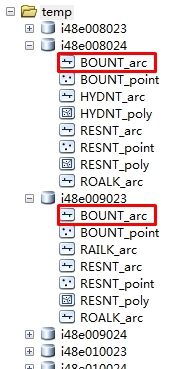众所周知,数据处理是GIS中一项重要且繁琐的工作,处理数据的工具和方法也太多了,在做数据处理的时候,经常会遇到这样的问题:对存储在不同gdb中、并且数据集名称相同的数据进行合并处理:
如图:数据组织如下,每个gdb中都存储了一些列FeatureClass,(但gdb中的FeatureClass数量并不相同)

思路是:
1.先对每个gdb中的数据进行处理,使得每个gdb中的featureclass数量和名称相同。由于对Engine比较熟悉,这里我是用Engine进行处理的,具体代码如下:
private function Execute(){ //初始执行函数: string templatePath = @"F: estout"; DirectoryInfo directoryInfo = new DirectoryInfo(templatePath); DirectoryInfo[] dirInfo = directoryInfo.GetDirectories(); string yy = dirInfo[0].Name; string FeatureClassName = "ROALK_arc"; //FeatureClass名称,这里可以设置一个数组,存储所有的FeatureClass for (int i = 0; i < dirInfo.Length; i++) { string gdbName = dirInfo[i].Name; //打开filegdb bool value = oper(@"F: estout" + gdbName, FeatureClassName);//判断FeatureClass是否存在 string path = @"F: estout" + gdbName; if (value == false) { copyFeatureClass(path, FeatureClassName); } } }
public bool oper(string filename,string featureClassName) //判断FeatureClass是否存在 { IWorkspace2 workspace = null; IWorkspaceFactory2 workspaceFactory = new FileGDBWorkspaceFactoryClass(); workspace = workspaceFactory.OpenFromFile(filename, 1) as IWorkspace2; IFeatureWorkspace featureWorkspace = workspace as IFeatureWorkspace; bool flag = workspace.get_NameExists(ESRI.ArcGIS.Geodatabase.esriDatasetType.esriDTFeatureClass, featureClassName); return flag; }
public bool oper(string filename,string featureClassName) //判断是gdb中是否存在某个FeatureClass { IWorkspace2 workspace = null; IWorkspaceFactory2 workspaceFactory = new FileGDBWorkspaceFactoryClass(); workspace = workspaceFactory.OpenFromFile(filename, 1) as IWorkspace2; IFeatureWorkspace featureWorkspace = workspace as IFeatureWorkspace; bool flag = workspace.get_NameExists(ESRI.ArcGIS.Geodatabase.esriDatasetType.esriDTFeatureClass, featureClassName); return flag; }
//拷贝所有的FeatureClass到gdb,并删除里面的数据,保证每个featureclass为空,注:D:DataShapefiles存储了所有的要合并的FeatureClass的空图层,便于拷贝。
private void convert() { IWorkspaceName sourceWorkspaceName = new WorkspaceNameClass { WorkspaceFactoryProgID = "esriDataSourcesFile.ShapefileWorkspaceFactory", PathName = @"D:DataShapefiles" }; IName sourceWorkspaceIName = (IName)sourceWorkspaceName; IWorkspace sourceWorkspace = (IWorkspace)sourceWorkspaceIName.Open(); // Create a name object for the target (file GDB) workspace and open it. IWorkspaceName targetWorkspaceName = new WorkspaceNameClass { WorkspaceFactoryProgID = "esriDataSourcesGDB.FileGDBWorkspaceFactory", PathName = @"D:DataPublic.gdb" }; IName targetWorkspaceIName = (IName)targetWorkspaceName; IWorkspace targetWorkspace = (IWorkspace)targetWorkspaceIName.Open(); // Create a name object for the source dataset. IFeatureClassName sourceFeatureClassName = new FeatureClassNameClass(); IDatasetName sourceDatasetName = (IDatasetName)sourceFeatureClassName; sourceDatasetName.Name = "BOUNT_arc"; sourceDatasetName.WorkspaceName = sourceWorkspaceName; // Create a name object for the target dataset. IFeatureClassName targetFeatureClassName = new FeatureClassNameClass(); IDatasetName targetDatasetName = (IDatasetName)targetFeatureClassName; targetDatasetName.Name = "BOUNT_arc"; targetDatasetName.WorkspaceName = targetWorkspaceName; // Open source feature class to get field definitions. IName sourceName = (IName)sourceFeatureClassName; IFeatureClass sourceFeatureClass = (IFeatureClass)sourceName.Open(); // Create the objects and references necessary for field validation. IFieldChecker fieldChecker = new FieldCheckerClass(); IFields sourceFields = sourceFeatureClass.Fields; IFields targetFields = null; IEnumFieldError enumFieldError = null; // Set the required properties for the IFieldChecker interface. fieldChecker.InputWorkspace = sourceWorkspace; fieldChecker.ValidateWorkspace = targetWorkspace; // Validate the fields and check for errors. fieldChecker.Validate(sourceFields, out enumFieldError, out targetFields); if (enumFieldError != null) { // Handle the errors in a way appropriate to your application. MessageBox.Show("Errors were encountered during field validation."); } // Find the shape field. String shapeFieldName = sourceFeatureClass.ShapeFieldName; int shapeFieldIndex = sourceFeatureClass.FindField(shapeFieldName); IField shapeField = sourceFields.get_Field(shapeFieldIndex); // Get the geometry definition from the shape field and clone it. IGeometryDef geometryDef = shapeField.GeometryDef; IClone geometryDefClone = (IClone)geometryDef; IClone targetGeometryDefClone = geometryDefClone.Clone(); IGeometryDef targetGeometryDef = (IGeometryDef)targetGeometryDefClone; // Cast the IGeometryDef to the IGeometryDefEdit interface. IGeometryDefEdit targetGeometryDefEdit = (IGeometryDefEdit)targetGeometryDef; // Set the IGeometryDefEdit properties. targetGeometryDefEdit.GridCount_2 = 1; targetGeometryDefEdit.set_GridSize(0, 0.75); IFeatureDataConverter featureDataConverter = new FeatureDataConverterClass(); IEnumInvalidObject enumInvalidObject = featureDataConverter.ConvertFeatureClass (sourceFeatureClassName, null, null, targetFeatureClassName, targetGeometryDef, targetFields, "", 1000, 0); // Check for errors. IInvalidObjectInfo invalidObjectInfo = null; enumInvalidObject.Reset(); }
2.合并,在ArcGIS中采用Python:
可以参考http://blog.csdn.net/esrichinacd/article/details/14146653
最后需要注意的地方是:在10.2的ArcMap中执行时会如下错误

我也是检查了好长时间,原因是10.2的ArcMap中执行结果会自动添加到ArcMap中,即使右键取消“添加至结果”也不行。(导致了第二次循环的时候合并的数据是结果集相同的数据的合并,所以会报上面错误)

所以这里,我们执行的时候可以到ArcCatalog中执行python脚本:
